Gaozong campaign of Tibet
| Gaozong campaign of Tibet | |||||||
|---|---|---|---|---|---|---|---|
 | |||||||
| |||||||
| Belligerents | |||||||
| Tang dynasty | Tibetan Empire | ||||||
| Commanders and leaders | |||||||
|
Emperor Gaozong of Tang Pei Xingjian Zhongshu Ling Li Jingxuan Liu Jingxian Heukchi Sangji Huangfu Wenliang Gong-bu shang-shu Liu Shenli †/ (POW) |
Tridu Songtsen Gar Trinring Tsendro Zao-po Su-he-gui | ||||||
In 678 AD, Tang forces suffered defeat against Tibetans in Qinghai, with only Heichi Changzhi achieving success through a night raid. Amid Tibetan advances and alliances with northern Turks, Tang officials urged withdrawal. In 679, after the Tibetan king’s death, peace was sought by his successor, while Tang general Pei Xingjian reclaimed four western garrisons.
Background
The Tibetans annexed the former territory of the Tuyuhun, conquered Qiuci, sacked Shule and attacked Gumo.[1][2][3]. The Tang force to the Western Regions retook Shule in the middle of 673 and reverted the Kingdom of Khotan and Qiuci to Tang suzerainty.[4]
Battle
In 678 AD, Emperor Gaozong of Tang initiated another anti-Tibetan campaign, but Tang troops led by Zhongshu-ling Li Jingxuan and Gongbu Shangshu Liu Shenli lost to the Tibetans in Qinghai, where Liu Shenli died. Only Zuo Lingjun Yuanwai Jiangjun Heichi Changzhi was successful in the campaign, having conducted a night assault on the Tibetans' camp while the Tibetans were taking over Qiangic territories and destroying Tang garrisons in the west. The Tibetans established connections with the northern Turks and Liu Qixian and Huangfu Wenliang, powerful figures in the court, called for a withdrawal from the battlefield. Subsequently, Heichi Changzhi won a battle against Zao Po and Su He Gui, Tibetan commanders, at Liangfeichuan and was promoted to Heyuan Shi to build up the defense of the border.[5][6]
In 679 AD, after the death of the Tibetan king, the boy king Qinu Xinong sought peace. The Tang court sent a representative, Langjiang Song Lingwen, to perform the ritual funerary duties. The actual power in the Tibetan court belonged to Qinling, the second son of Ludongzan, who was still in place. In that same year Tang general Pei Xingjian was overseeing the return of a Persian prince and recaptured the four western garrisons controlled by the Tibetans.[7][8][9][10]
References
- ^ Wang, Zhenping (2013-10-31). Tang China in Multi-Polar Asia: A History of Diplomacy and War. University of Hawaii Press. p. 147. ISBN 978-0-8248-3644-3.
- ^ Graff, David Andrew (2002). Medieval Chinese Warfare, 300-900. Routledge. p. 206. ISBN 978-0-415-23954-7.
- ^ Xiong, Victor Cunrui (2009). Historical Dictionary of Medieval China. Bloomsbury Publishing PLC. ISBN 978-0-8108-6053-7.
- ^ Wang, Zhenping (2013-10-31). Tang China in Multi-Polar Asia: A History of Diplomacy and War. University of Hawaii Press. p. 148. ISBN 978-0-8248-3644-3.
- ^ Yuan, Hong (2022-11-14). From the Khitans to the Jurchens & Mongols: A History of Barbarians in Triangle Wars & Quartet Conflicts. iUniverse. ISBN 978-1-6632-4258-7.
- ^ Jade-Carving Chisel and Luminous Ocean: Selected Essays by Jao Tsung-i on Literature and Related Topics. BRILL. 2024-10-28. p. 198. ISBN 978-90-04-52356-2.
- ^ Whiting, Marvin. Imperial Chinese Military History. iUniverse. pp. 267–268. ISBN 978-0-595-22134-9.
- ^ Wang, Zhenping (2013-10-31). Tang China in Multi-Polar Asia: A History of Diplomacy and War. University of Hawaii Press. p. 148. ISBN 978-0-8248-3644-3.
- ^ Mohana Chander. Historical Atlas Of Central Asia Yuri Bregel Brill. p. 17.
- ^ Xiong, Victor Cunrui (2009). Historical Dictionary of Medieval China. Bloomsbury Publishing PLC. p. 45. ISBN 978-0-8108-6053-7.